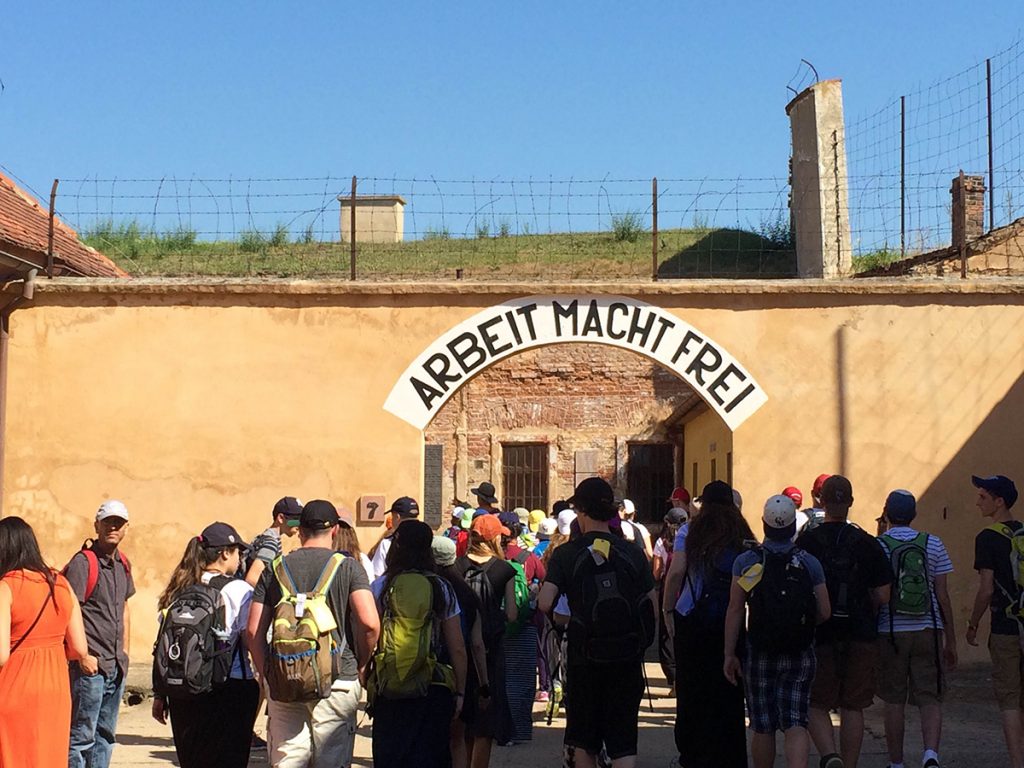While everyone has their own personal history that helps shape them, there are also many events that speak to us all as Jews, such as the devastation of Holocaust or the creation of the state of Israel. This shared cultural knowledge helps us to understand more about our heritage, which in turn helps us understand more about ourselves. Different experiences in our lives act as catalysts for these periods of self-discovery and reflection. For some teens, going on a USY Summer Experience has been once such catalyst.
For the last sixty years, teenagers traveling with USY Israel Pilgrimage have had the amazing opportunity to grow as individuals amongst their peers while touring sites that are important to their Jewish heritage. There are so many different parts of the trip that leave a long-lasting impact, from seeing concentration camps in Poland to praying at the Kotel in Jersualem.
Amanda Gordon, a rising senior from Roslyn, NY, is one of the hundreds of teens who have been impacted by these trips. Below is a moving personal essay Amanda wrote about her experience on last year’s Eastern Europe/Israel Pilgrimage trip.

By Amanda Gordon
My long skirt dragged in the mud as I walked quickly to catch up with my friend Talia. She grabbed my hand as we entered a small wooden building. There was a stale smell, a horrible amalgam of moisture and years of neglect. The room was filled from floor to ceiling with cages of shoes. Some shoes were big, some were the size of my palm, but all were covered in a layer of dirt. After almost a week of walking through complexes of death and rotten wood, I had never felt salty water trickle down from my blue eyes. As I stood in a room full of white shoes turned black, I felt the weight of innocent souls turned to ashes. After a few moments, Talia began to cry into my shoulder. I have never thought of myself as a comforting person, but somehow I managed to rub the sleeve of her purple Patagonia raincoat. I think it comforted me just as much as it comforted her.
I wanted my face to feel hot and blotchy. I wanted to cry into someone else’s shoulder. I wanted to feel like the shoes in the cages were part of my story. I wanted to feel human.
I reached out to touch one small shoe.
“What are you doing?” Talia asked between sniffles.
I did not know what I was doing, there was no protocol for things like this. I touched the shoe and waited for something, but my eyes remained as dry as the dusty floor.
Before leaving, we all joined hands and began to sing. I did not know Hebrew as well as the others, so I stared at my white Adidas sneakers and mumbled along. We swayed our bodies to the undulating cadences of the melody. My face remained stoic, as much as I wanted it to shrivel up like Talia’s.
The sweat building in my palm triggered a rush of thoughts through the synaptic clefts of my brain, which seemed to ignore the increasing blood flow through the valves of my heart. I remembered the first time I had visited the Western Wall in Jerusalem. I remembered how cold my forehead felt against the hard limestone. I remembered craning my neck to look past the wall and up to the sky.
The song ended. We left the desolate room of white shoes turned black.
A half hour later, we were back on the bus. I tasted the briny olives of my sandwich as I looked out the window, watching the Polish countryside blur into greens and yellows. We had just started watching The Fiddler on the Roof. Thoughts of my great grandparents living in the Pale of Settlement mixed with the lush orchestral arrangements of the opening scene of the movie. I clutched the Star of David around my neck. As my peers laughed at the opening monologue, I began to cry.
It was in that moment that I realized that my identity and humanity were not contingent on aligning my emotions with others. I realized that my role among the collective of a minority could never be compromised by how well I spoke a language or how successfully I kept up with nuanced ritualistic observances. I realized that the beauty of my culture is often derived from sadness, and I realized that I occupied a unique patch on the quilt of adversity and resilience, the quilt of my people.